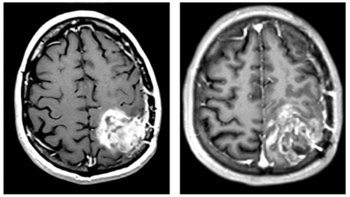
There are several thousand drugs available to treat a wide range of brain diseases, but they cannot penetrate the blood–brain barrier (BBB), which protects pathogens in blood from reaching the brain. The BBB also prevents most drugs from gaining access to the parenchyma, the brain’s functional tissue, impeding the treatment of neurodegenerative disorders such as Parkinson’s and Alzheimer’s disease.
A team led by Elisa Konofagou at Columbia University is developing a novel technique that could facilitate targeted drug delivery into the brain and enable drugs to treat brain diseases more focally. The researchers are using transcranial focused ultrasound (FUS) along with systemically administered microbubbles to create a localized and transient opening that allows drugs to cross the BBB.
Working with Serge Przedborski‘s group at Columbia University Irving Medical Center, the team has demonstrated that the combination of FUS and administration of neurotrophic factors (through protein or gene delivery) in a mouse model of Parkinson’s could partly restore dopaminergic pathways, the neurons in the brain that are affected in early Parkinson’s disease. Neither FUS alone nor delivery of neurotrophic factors without FUS had the same effect (J. Control. Release 10.1016/j.jconrel.2019.03.030).
“We found both behavioural and anatomical neuronal improvements in the brain,” says Konofagou. “This is the first time that anyone has been able to restore a dopaminergic pathway with available drugs at the early stages of Parkinson’s disease. We were able to curb the rapid progression of neurodegeneration while improving the neuronal function. We expect our study will open new therapeutic avenues for the early treatment of central nervous system diseases.”
For the study, the researchers developed a device that uses a neuronavigation system to direct the treatment in real time. The US Food and Drug Administration (FDA) has now assigned the team an investigational device exemption to use this device in clinical trials to test its safety in Alzheimer’s patients.
“Neurosurgeons use such systems all the time to guide neurosurgery,” says Antonios Pouliopoulos, who helped develop the clinical neuronavigation system. “Our group just replaced the surgical instrument with an ultrasound transducer to perform our non-invasive procedure.”
Konofagou’s is the only academic laboratory in the US to receive FDA approval for ultrasound-assisted BBB opening. The researchers note that, unlike other approaches under development, their technique is MRI-independent and does not require nanoparticles to facilitate drug delivery.
The treatment device uses a single-element transducer, making it smaller, faster and 10 times cheaper than current helmet-shaped, 1024-element transducer systems that employ MRI guidance. Because the system is portable, doctors will be able to treat patients anywhere in a hospital and, in future, even at a patient’s home. Treatment will take less than 30 min, compared with three to four hours for MRI-guided therapy, and can be monitored in real-time.
The first trial with the device will be with Alzheimer’s patients, after which Konofagou plans to work with Parkinson’s patients.

Clinical trial explores BBB opening in fight against Alzheimer’s
“We all have loved ones with neurodegenerative disorders,” Konofagou adds. “My grandmother has been suffering from dementia for more than five years, so I know first-hand how essential it would be to have a simple device that can be wheeled into the patient’s home and offer a higher quality of life, especially for our rapidly aging population. And there are so many deadly diseases like brain tumours that affect people of all ages, with no cure yet in sight. That’s why we want to bring our research so rapidly to the clinic.”



